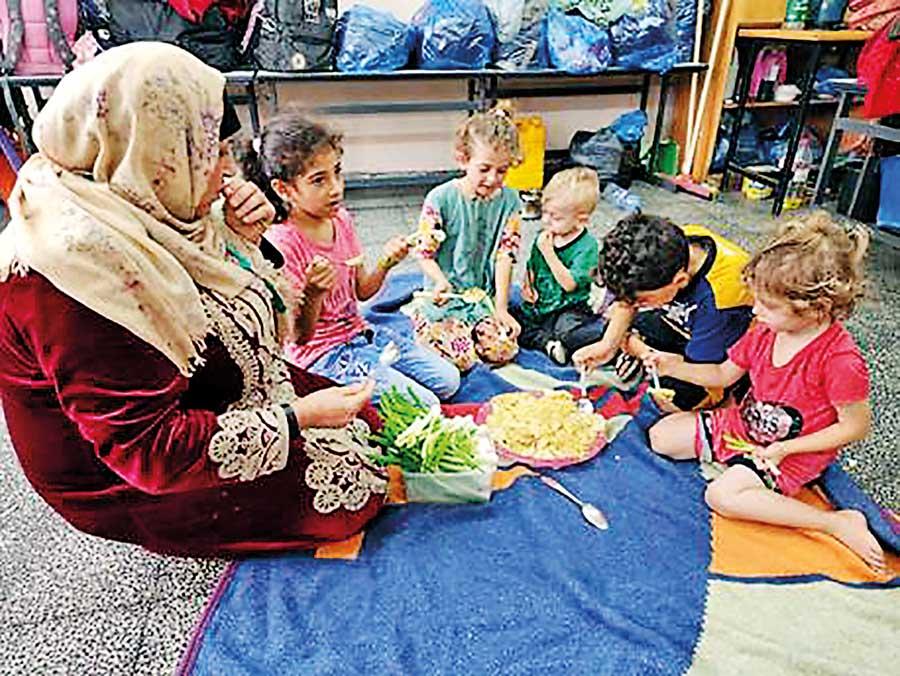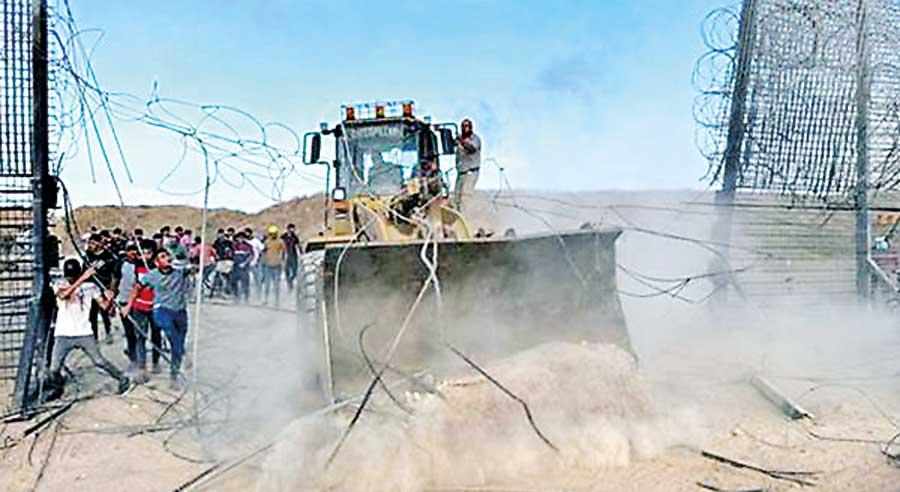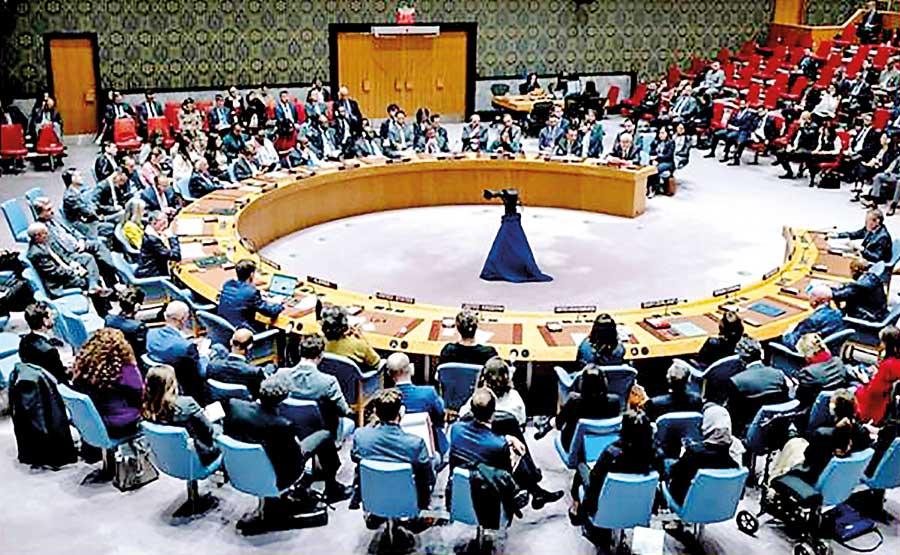Promoting reconciliation, accountability and human rights in Sri Lanka vis-à-vis Gaza-by Air Chief Marshal Gagan bulathsingala
Source:Dailymirror
- Both Hamas and the LTTE were designated by the United States as foreign terrorist organizations on the same day Oct 8, 1997
- Gaza is running out of essential commodities such as water, fuel, and supplies amid an Israeli aid blockade
- The UN Security Council in a press statement said that they strongly condemn the LTTE for its acts of terrorism over many years
Sri Lanka said that the armed forces ended the Liberation Tigers of Tamil Eelam (LTTE) conflict in May 2009 through a “Humanitarian Operation”, but the successive governments still defend a UN-led probe into the alleged human rights violations.
defend a UN-led probe into the alleged human rights violations.
At the turn of the century, it wasn’t uncommon for Hamas and LTTE- widely known as the Tamil Tigers- to find reference in the same debates as governments around the world weighed how to deal with these two militant groups.
Both Hamas and the LTTE were designated by the United States as foreign terrorist organizations on the same day Oct 8, 1997. So was the Hezbollah, the Iran-backed militant group operating in Lebanon.
Fighting broke out between Israel and Hamas on October 7, 2023. Hamas is the militant Islamist group that has controlled Gaza since 2006. Hamas fighters fired rockets into Israel and stormed southern Israeli cities and towns across the border of the Gaza Strip, killing and injuring hundreds of soldiers and civilians and taking dozens of hostages. The attack took Israel by surprise, though the state quickly mounted a deadly retaliatory operation. The attack came with a surprise series of coordinated efforts enabled by Hamas to breach at 29 points, according to the Israel Defence Forces. Though there were Israeli guard towers positioned every 500 feet along the perimetre, the fighters appeared to encounter little resistance.
https://bmkltsly13vb.compat.objectstorage.ap-singapore-1.oraclecloud.com/cdn.sg.dailymirror.lk/assets/uploads/image_19eedd90c4.jpg
Experts have expressed concern that another extremist group with Iranian backing, Hezbollah, would likely be drawn into the war, thereby expanding the conflict beyond Israeli and Palestinian borders
The day after the attack, the Israeli cabinet formally declared war against Hamas, followed by a directive from the Defence Minister to the Israeli Defence Forces (IDF) to carry out a “complete siege” of Gaza. Since then, the two sides have traded daily rocket fire, and Israel ordered more than one million Palestinian civilians in northern Gaza to evacuate ahead of a possible ground assault. Meanwhile, Gaza is running out of essential commodities such as water, fuel, and supplies amid an Israeli aid blockade, and the conflict risks spreading as cross-border strikes escalate in Lebanon and Syria. Further, U.S. military aircraft have carried out strikes in eastern Syria against facilities associated with Iranian-backed militant groups believed to be responsible for more than a dozen rocket and drone attacks on American troops in Iraq and Syria.
Background
The Israeli-Palestinian conflict dates back to the end of the nineteenth century. In 1947, the United Nations adopted Resolution 181, known as the Partition Plan, which sought to divide the British Mandate of Palestine into Arab and Jewish states. On May 14, 1948, the State of Israel was created, sparking the first Arab-Israeli War. The war ended in 1949 with Israel’s victory, but 750,000
Palestinians were displaced, and the territory was divided into 3 parts: The State of Israel, the West Bank (of the Jordan River), and the Gaza Strip. Over the years to follow tensions rose in the region, particularly between Israel, Egypt, Jordan, and Syria. Following the 1956 Suez Crisis and Israel’s invasion of the Sinai Peninsula, Egypt, Jordan, and Syria signed mutual defence pacts in anticipation of a possible mobilization of Israeli troops. In June 1967, following a series of manoeuvres by Egyptian President Abdel Gamal Nasser, Israel preemptively attacked Egyptian and Syrian air forces, starting the Six-Day War. After the war, Israel gained territorial control over the Sinai Peninsula and Gaza Strip from Egypt; the West Bank and East Jerusalem from Jordan; and the Golan Heights from Syria. Six years later, in what is referred to as the Yom Kippur War or the October War, Egypt and Syria launched a surprise two-front attack on Israel to regain their lost territory; the conflict did not result in significant gains for Egypt, Israel, or Syria, but Egyptian President Anwar al-Sadat declared the war a victory for Egypt as it allowed Egypt and Syria to negotiate over previously ceded territory. Finally, in 1979, following a series of cease-fires and peace negotiations, representatives from Egypt and Israel signed the Camp David Accords, a peace treaty that ended the thirty-year conflict between Egypt and Israel.
Even though the Camp David Accords were a pair of political agreements signed by then-Egyptian President Anwar Sadat and then-Israeli Prime Minister Menachem Begin on 17 September 1978, to improve relations between Israel and its neighbours, the question of Palestinian self- determination and self-governance remained unresolved. In 1987, hundreds of thousands of Palestinians living in the West Bank and Gaza Strip rose against the Israeli government in what is known as the first Intifada. An Intifada is a rebellion uprising or a resistance movement. It is a key concept in contemporary Arabic usage referring to a legitimate uprising against oppression.
Etymology
The 1993 Oslo I Accords mediated the conflict, setting up a framework for the Palestinians to govern themselves in the West Bank and Gaza, and enabled mutual recognition between the newly established Palestinian Authority and Israel’s government. In 1995, the Oslo II Accords expanded on the first agreement, adding provisions that mandated the complete withdrawal of Israel from 6 cities and 450 towns in the West Bank.
Prime Minister Benjamin Netanyahu’s most far-right and religious government in Israel’s history was inaugurated in late December 2022. PM Netanyahu is the longest-tenured PM in Israel’s history, having served for a total of over 16 years. The coalition government is led by PM Netanyahu, and his Likud party comprises two ultra-Orthodox parties and three far-right parties, including the Religious Zionism party, an ultranationalist faction affiliated with the West Bank settler movement. To reach a governing majority, PM Netanyahu made a variety of concessions to his far-right partners. Opponents have criticized the government’s stated prioritization of the expansion and development of Israeli settlements in the occupied West Bank. The October 2023 conflict between Israel and Hamas marks the most significant escalation of the ongoing Israeli- Palestinian conflict in several decades.
Compare and Contrast
Puthukkudiyirippu was the Liberation Tigers of Tamil Eelam (LTTE) final bastion held during the Northern Theater of Eelam War IV in Sri Lanka.
In the final conflict, the armed confrontation over control over Puthukkudiyirippu was bitterly fought between the Sri Lankan Military and the LTTE from January 2009 until mid-May 2009. The battle was different from others as the area was an urban terrain. Both parties adopted hit-and-run strategies until the decisive battle was fought where more LTTE cadres and an array of top leaders perished within a very short period. The major tiger offensive was outmanoeuvred by the Sri Lanka military in a limited area of the land.
Fighting in the ‘No-Fire Zone’
Sri Lankan troops were able to push the Tamil Tigers into the no-fire zone set up for the civilians. The LTTE then built a long bund in the no-fire zone, trapping civilians, but the Sri Lankan Military was able to destroy and capture this.
While the Tamil exodus from the ‘no-fire zone’ continued, the UN estimated that around 6,500 civilians may have been killed and another 14,000 wounded between January 2009 and April 2009. https://www.theguardian.com/world/2009/apr/24/srilanka. Also, the BBC reported that the land recaptured by the Sri Lankan troops from the rebels was totally depopulated and utterly devastated.
As the fighting continued, a group of independent United Nations experts called on the Human Rights Council to urgently set up an international inquiry to address the “critical” situation in Sri Lanka amidst fighting between the Sri Lankan Military and the LTTE. According to the UN Office for the Coordination of Humanitarian Affairs (OCHA), over 196,000 people fled the conflict zone, a shrinking pocket of land on the north-east coastline, where clashes continued between government troops and the LTTE, while approximately at least 50,000 people were still trapped there. A UN spokesman in Colombo said more than 100 children died during the “large-scale killing of civilians” and described the situation in northern Sri Lanka as a “bloodbath”. UN Secretary-General Ban Ki-moon said, “he was appalled at the killing of hundreds of Sri Lankan civilians caught in the middle of hostilities between the army and separatist Tamil rebels over the weekend”. Secretary-General Ban Ki-moon voiced deep concern over the continued use of heavy weapons in the conflict zone, but also stressed that the “reckless disrespect shown by the LTTE for the safety of civilians has led to thousands of people remaining trapped in the area”. https://www.unocha.org/publications/report/sri-lanka/common-humanitarian-action-plan-chap- appeal-2009-sri-lanka
Opponents have criticised the government’s stated prioritization of the expansion and development of Israeli settlements in the occupied West Bank. The October 2023 conflict between Israel and Hamas marks the most significant escalation of the ongoing Israeli-Palestinian conflict in several decades
The UN Security Council issued the following press statement, “The members of the Security Council strongly condemn the Liberation Tigers of Tamil Eelam (LTTE) for its acts of terrorism over many years, and for its continued use of civilians as human shields, and acknowledge the legitimate right of the Government of Sri Lanka to combat terrorism. The members of the Security Council demand that the LTTE lay down its arms and allow the tens of thousands of civilians still in the conflict zone to leave. The members of the Security Council express deep concern at the reports of continued use of heavy calibre weapons in areas with high concentrations of civilians, and expect the Government of Sri Lanka to fulfil its commitment in this regard.”
https://press.un.org/en/2009/sc9659.doc.htm
Sri Lankan troops broke through LTTE defences and captured the last section of coastline held by Tamil Tiger rebels by 16th May 2009. The Sri Lankan troops reported it was set to “clear” remaining rebel-held land within days. Later the Sri Lankan military claimed, citing allegedly intercepted LTTE communications, that the rebels were preparing for a mass suicide after being effectively cut off from escape routes. Some rebels were reported to have blown themselves up. In its resolution, A/HRC/25/1 adopted in March 2014 on “Promoting reconciliation, accountability and human rights in Sri Lanka”, the United Nations Human Rights Council requested the UN High Commissioner for Human Rights to “undertake a comprehensive investigation into alleged serious violations and abuses of human rights and related crimes by both parties in Sri Lanka during the period covered by the Lessons Learnt and Reconciliation Commission (LLRC), and to establish the facts and circumstances of such alleged violations and of the crimes perpetrated with a view to avoiding impunity and ensuring accountability, with assistance from relevant experts and special procedures mandate holders”.
https://documents-dds- ny.un.org/doc/UNDOC/GEN/G14/132/86/PDF/G1413286.pdf?OpenElement.
The UN Security Council issued the following press statement, “The members of the Security Council strongly condemn the Liberation Tigers of Tamil Eelam (LTTE) for its acts of terrorism over many years, and for its continued use of civilians as human shields, and acknowledge the legitimate right of the Government of Sri Lanka to combat terrorism. The members of the Security Council demand that the LTTE lay down its arms and allow the tens of thousands of civilians still in the conflict zone to leave. The members of the Security Council express deep concern at the reports of continued use of heavy calibre weapons in areas with high concentrations of civilians, and expect the Government of Sri Lanka to fulfil its commitment in this regard.”
https://press.un.org/en/2009/sc9659.doc.htm
Sri Lankan troops broke through LTTE defences and captured the last section of coastline held by Tamil Tiger rebels by 16th May 2009. The Sri Lankan troops reported it was set to “clear” remaining rebel-held land within days. Later the Sri Lankan military claimed, citing allegedly intercepted LTTE communications, that the rebels were preparing for a mass suicide after being effectively cut off from escape routes. Some rebels were reported to have blown themselves up. In its resolution, A/HRC/25/1 adopted in March 2014 on “Promoting reconciliation, accountability and human rights in Sri Lanka”, the United Nations Human Rights Council requested the UN High Commissioner for Human Rights to “undertake a comprehensive investigation into alleged serious violations and abuses of human rights and related crimes by both parties in Sri Lanka during the period covered by the Lessons Learnt and Reconciliation Commission (LLRC), and to establish the facts and circumstances of such alleged violations and of the crimes perpetrated with a view to avoiding impunity and ensuring accountability, with assistance from relevant experts and special procedures mandate holders”.
https://documents-dds- ny.un.org/doc/UNDOC/GEN/G14/132/86/PDF/G1413286.pdf?OpenElement.
War crimes investigations
The United Nations Human Rights Commission drafted a resolution on “Promoting reconciliation, accountability and human rights in Sri Lanka” and requested its High Commissioner Ms. Navi Pillay to undertake a comprehensive investigation into alleged serious violations and human rights abuses that have taken place during the war. Subsequently, the Human Rights Commissioner directed the setting up of the OHCHR Investigation in Sri Lanka (OISL) in March 2014, and Sri Lanka is accused of perpetuating war crimes.
Israel-Gaza -vetoes Security Council resolution
The US vetoed a UN Security Council resolution that would have called for “humanitarian pauses” to deliver lifesaving aid to millions in Gaza. The failure of the Council to make its first public intervention in the Israel- Gaza crisis followed the rejection of a Russian-backed draft on the 18th of October, 2023. In the UN, veto power is the ability of the five permanent members of the UN Security Council to reject any substantive decision of the Security Council. The Security Council consists of ten elected members, and five permanent members– China, the United States, France, the United Kingdom, and the Russian Federation. Veto power is considered one of the most significant distinctions between permanent and non-permanent members. UN Security Council resolution called for “humanitarian pauses” to deliver lifesaving aid to millions in Gaza was voted by 12 in favour (Albania, Brazil, China, Ecuador, France, Gabon,Ghana, Japan, Malta, Mozambique, Switzerland, UAE), 01 against: 1 (US) and 02 abstained: 2 Russia, UK. A ‘no’ vote from any one of the five permanent members of the Council stops action on any measure put before it.
US rejection
US Ambassador Linda Thomas-Greenfield explained her country’s veto in the Council chamber saying “This resolution did not mention Israel’s right of self-defence.” “Israel has the inherent right of self-defence as reflected in Article 51 of the UN Charter,” she added, noting that the right was reaffirmed by the Council in previous resolutions on terrorist attacks, “this resolution should have done the same.” She said that though the US could not support the resolution, it will continue to work closely with all Council members on the crisis, “just as we will continue to reiterate the need to protect civilians, including members of the media, humanitarian workers, and UN officials.” Ambassador Thomas-Greenfield also noted the US is also engaged in on-the-ground diplomacy, with the visit of President Biden, and other senior officials. “Yes, resolutions are important, and yes, this Council must speak out. But the actions we take, must be informed by the facts on the ground and support direct diplomacy that can save lives,” she said. https://news.un.org/en/story/2023/10/1142507
As per the records since 1954, on 34 occasions US has used veto power to strike down resolutions related to the Israel-Palestine situation.
https://www.aljazeera.com/news/2023/10/26/how-the-us- has-used-its-veto-power-at-the-un-in-support-of-israel
Second resolution
This was the Council’s second open meeting on the situation in Gaza. Ambassadors had met, mainly behind closed doors, on the crisis, including meetings on the 8th and 13th of October. It was followed by a briefing on the crisis from UN principals.
The action on the Brazilian-led draft resolution follows the defeat of a Russian-led text calling for a humanitarian ceasefire in Gaza which did not include any mention or condemnation of the extremist group Hamas, who controlled the Gaza Strip. That resolution received five votes in favour (China, Gabon, Mozambique, Russia, and the United Arab Emirates) and four against (France, Japan, UK, and the US), with six abstentions (Albania, Brazil, Ecuador, Ghana, Malta, and Switzerland). https://www.aljazeera.com/news/2023/10/26/two-more-resolutions-to-end- gaza-violence-fail-at-un-security-council
Did Mossad fail?
Dozens of Hamas fighters were able to enter Israeli towns with the least resistance and hit military targets across the border. This raised many questions on how Israel’s formidable intelligence failed to see what transpired. The question is how Mossad, Israel’s main spy agency, which has a wide range of espionage technologies and has long relied on moles inside the Palestinian armed groups missed the information. The moles routinely provide Mossad with detailed intel on the operations of such networks. Such a massive and deadly attack by Palestinian fighters launched a land, air and sea-based incursion simultaneously shouldn’t have gone unnoticed.
One opinion holds that Hamas, weakened by years of Gaza blockade, was not viewed by Israel as capable of launching an attack on such a scale and it was the Iran-backed Hezbollah in Lebanon that posed a more likely threat. Arguably Hamas took advantage of this perception, gradually putting into action its attack plan – from building rockets it fired at Israeli cities to tearing down, with a bulldozer, the barbed wire fence that separates Gaza from Israel – without drawing immediate response from Tel Aviv. https://www.trtworld.com/middle-east/why-did-mossad-fail-to-foresee-hamas-attack-on-israel- 15321552.
Concerns and complexities
Following the outbreak of conflict between Israel and Hamas on October 7, President Joe Biden made a strong statement in support of Israel. On the same day that Israel declared war against the terrorist group, the US announced that it would send renewed shipments of arms and move its Mediterranean Sea warships closer to Israel. While the UN Security Council called an emergency meeting to discuss the renewed violence, the members failed to come to a consensus statement. Given the history of ruthlessness when Israel and Palestinian extremist groups have fought in the past, international groups quickly expressed concern for the safety of civilians in Israel and the Palestinian territories as well as those being held hostage by militants in Gaza. The increasing loss of life is a primary concern in the conflict.
While the US did not immediately confirm reports that Iranian intelligence and security forces directly helped Hamas plan its attack, Iran is known to have a well-established patronage relationship with Hamas and other extremist groups across the Middle East. Experts have expressed concern that another extremist group with Iranian backing, Hezbollah, would likely be drawn into the war, thereby expanding the conflict beyond Israeli and Palestinian borders. By 9th October, reports surfaced that the Israel Defense Forces (IDF) was firing at targets within Lebanon, where Hezbollah is based. An Israeli statement on the matter did not clarify the purpose of the cross-boundary operation.
A 2023 effort by the US to help broker a normalization accord between Israel and Saudi Arabia was thrown into chaos by the October conflict. Saudi Arabia has long advocated for the rights and safety of Palestinian Arab populations in Israel, the West Bank, and Gaza. Especially in Gaza, those populations are now in the path of IDF operations, jeopardizing the progress the Israelis and Saudis made toward a common understanding.
Sri Lanka has experienced periods of conflict, which lasted for nearly three decades and ended in 2009. Since the end of the war, successive Sri Lankan governments are still working on post- conflict reconciliation, economic development, and political stability.
Gaza, on the other hand, is a Palestinian territory located in the eastern Mediterranean, bordered by Israel and Egypt. It is a small strip of land that has been a focal point of the Israeli-Palestinian conflict for many years.
The territory is governed by Hamas, a Palestinian political and military organization, which Israel and some other countries classify as a terrorist group. The situation in Gaza has been marked by long-standing Israeli blockades, periodic conflict with Israel, and complex political dynamics. With the recent twists of events, the efforts to find a peaceful resolution to the Israeli-Palestinian conflict continue would be a major international worry.
Gaza being one of the most densely populated areas in the world faces significant socio-economic challenges, including high levels of poverty and limited access to resources due to the ongoing conflict. The situation poses a significant health risk of epidemics and diseases in a densely populated Gaza Strip. Of the 2.2 million people living in the Strip, nearly half of them are children, who urgently need life-saving humanitarian aid and basic services. Further, it is reported at least 43% of all housing units have been either destroyed or damaged since the start of the hostilities, according to the Ministry of Public Works and Housing in Gaza. https://www.unicef.org/sop/stories/humanitarian-crisis-gaza-strip.
Optimism
Though Sri Lanka and Gaza are not directly connected, both have experienced conflicts and challenges and have their share of political and humanitarian challenges, though they differ in terms of their geographic locations, histories, and the nature of the conflicts that have been experienced. However, the underlying issues and circumstances in each region are quite dissimilar, and they are often discussed separately in the context of international relations and conflicts.
Food for thought is, do the international players have the same rule book that was applied to Sri Lanka, being applied in the context of ongoing conflict in Gaza?
Also, as the fighting continues, hope independent experts will call on the Human Rights Council to urgently set up an international inquiry to address the “critical” situation in Gaza. Many have been killed, injured, taken hostage or displaced on both sides.
In summary, fair treatment and natural justice are core principles that promote peace, justice, fairness, and the protection of human rights. The optimism of the international stakeholders who play a crucial role should ensure that nations’ and populations’ rights are upheld when making decisions and taking actions that are equitable, unbiased, and just.
(The writer is a Formerly Commander of the Sri Lanka Air Force and Ambassador to Afghanistan and the President of the Association of Retired Flag Rank Officers)










